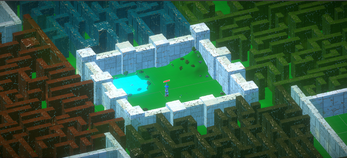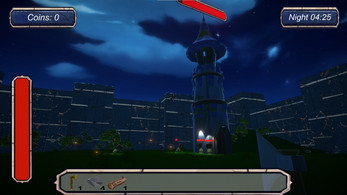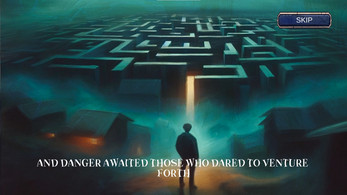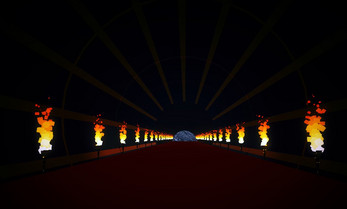Maze Legacy
A downloadable maze for Windows
Maze Legacy
Navigate a treacherous maze in a post-apocalyptic world to defeat Dr.Zomboboss and restore hope.
Controls

Story
In a post-apocalyptic world ravaged by Dr. Zomboboss's plague, the once-great civilizations have crumbled into a vast, labyrinth known as the maze. As humanity's last hope, you awaken within the heart of this maze, tasked with a daunting mission: navigate its dangers, defeat the malevolent Dr. Zomboboss, and find the key to the tower which will take you back to your world.
Gameplay
"Maze Legacy" blends survival, combat, and puzzle-solving in a dynamic environment that evolves constantly. The game features a day-night cycle critical to strategy and survival. By day, players gather resources and craft defenses in the safety of their village. At night, zombies emerge from the maze, attacking the central tower that players must defend using their crafted tools and traps.
After repelling the night attack, players explore the maze, seeking tools to defeat Dr. Zomboboss. However, they must return to the village before dawn to avoid being trapped inside the maze overnight, facing even greater dangers without the safety of their defenses. This cycle of preparation, defense, and exploration requires players to balance building, combat, and puzzle-solving, progressively moving closer to the ultimate showdown with Dr. Zomboboss.
Post Mortem
What went right?
Effective Team Communication and Organization
Our project kicked off with a highly productive brainstorming session that established the theme, design concept, and initial mechanics for our game. This early alignment was crucial and set the stage for the entire development process. Each team member received specific research and development tasks tailored to their skills, fostering a focused and efficient workflow. We maintained regular communication through weekly meetings to monitor progress and ensure that everyone remained on the same page. Tools like GitHub Desktop and Discord were instrumental in facilitating seamless updates and real-time communication, ensuring that all team members were informed and engaged throughout the development process.
Supporting Individual Growth and Team Synergy
A key to our success was our commitment to supporting each team member’s personal and professional goals within the project’s framework. By allowing programmers to take charge of scripting and mechanics, artists to drive the game’s visual elements, and level designers to shape the game environment, we leveraged individual strengths to enhance our collective output. This approach not only improved the game’s quality but also ensured that each team member felt valued and motivated. Our prior experience working together in a previous game jam reinforced our synergy, enabling us to collaborate more effectively and anticipate each other’s needs and work styles.
Successful Implementation of Game Mechanics
The structured and continuous dialogue from the initial brainstorming through to the weekly check-ins played a critical role in the successful implementation of complex game mechanics. This consistent communication allowed for effective integration of various elements, such as multiple enemy types, a final boss fight, an inventory system, and regenerating supplies. The collaboration between programmers and the level designer, facilitated by clear and frequent communication, enabled them to convey their vision to the artists effectively. As a result, the artists could align closely with the project’s aesthetic goals, which significantly enhanced the visual coherence and polish of the final product.
What went wrong/what problems did you face?
Complexities in Maze Implementation
One notable deviation from our initial plans involved the implementation of the game's maze mechanics. The original design for the maze proved too complex, raising concerns among the programmers about its compatibility with the storyline. After much deliberation, the decision was made to revise the design, leading to the creation of a simplified version based on the initial draft. This redesign process, however, resulted in a significant delay. Two weeks were initially spent refining the enemy mechanics, as our programmer was tasked with developing a robust system. This learning phase consumed a considerable amount of time and subsequently created a backlog, hindering the integration of various systems by the player programmer. In hindsight, a more focused approach on solidifying the basic mechanics and aligning them with the storyline from the outset would have been beneficial.
Transitioning from 2D to 3D Art
Additionally, our game artist, who had primarily worked in 2D, faced significant challenges transitioning to 3D modeling using Blender. The initial models did not meet expectations, reflecting the steep learning curve associated with mastering new software. Over time, through persistent practice and adaptation, the quality of the models improved noticeably. However, certain design elements from the concept art had to be modified for the 3D models, especially in aspects that were challenging to rig. Despite these obstacles, the final outcomes were commendable, showcasing the artist's successful transition from 2D to 3D. This experience not only broadened the artist's technical skill set but also enriched their capability to translate artistic concepts across different dimensions.
How did you overcome those problems?
A critical factor in navigating the challenges of our project was the exceptional collaboration and communication among team members. The synergy between the artist, the level designer, and the programmers played a pivotal role in our ability to address and overcome setbacks efficiently.
During a particularly challenging phase, when we encountered backlogs in level design and an accumulation of pending post-processing tasks, our programmers stepped up remarkably. One programmer, in particular, took the initiative to address these delays, ensuring that we remained on track for our delivery timeline. This proactive approach was facilitated by our active use of the Discord platform, which proved invaluable for maintaining open lines of communication.
The platform enabled team members to promptly share updates, flag issues, and redistribute tasks as needed. This agility in communication allowed us to swiftly tackle assignments that were critical for upcoming check-ins and the final draft of our game. The readiness of team members to assist one another not only kept the project moving forward but also reinforced a supportive team environment, crucial for navigating the complexities of game development.
What changes were made and why?
In the course of our project, we encountered several challenges that necessitated adjustments to our original development plan, as outlined in our design document. Due to time constraints and the complexities involved in certain tasks, we made strategic decisions to modify some of our initial objectives to ensure timely completion and maintain the quality of our game.
Maze Design Modifications
Originally, we envisioned creating a "living maze" that would dynamically change its layout every few days, adding a layer of urgency and challenge by compelling players to escape before the next transformation. This concept was intended to be enhanced with checkpoints and portals to aid in navigation. However, as development progressed, it became clear that polishing this dynamic system alongside other game mechanics was overly ambitious given our timeline. Consequently, we simplified the maze concept to feature static sections with doors that randomly open or close. This adjustment allowed players to explore various uniquely themed sections of the maze in search of a key to progress, maintaining an element of unpredictability and exploration within the constraints of our revised scope.
Changes to Weapon System
Another significant deviation from our initial plan involved the weapons and upgrade system. We initially proposed a more complex system where players could acquire special gems within the maze to upgrade their weapons. However, as the project deadline approached and resources were prioritized elsewhere, we decided to scale back this feature. Instead of multiple weapons and an intricate upgrade system, we focused on perfecting two basic weapons and a health potion. This change ensured that we could deliver a polished, functional combat system within the limited time available.
What did you learn?
Throughout the project, each team member acquired a range of valuable skills, tailored to their specific roles and challenges.
Our artist, primarily experienced in 2D art, ventured into 3D modeling and animation using Blender. This transition not only expanded her skill set but also enhanced her ability to contribute more dynamically to the game's visual elements.
The level designer deepened his expertise in managing terrain features and mastering Unity's post-processing capabilities. Additionally, he tackled the user interface, gaining substantial knowledge in how UI components function within Unity and how to manage them effectively on the canvas.
Our enemy developer focused on combat mechanics, learning to utilize colliders for enemy attacks and mastering the navigation mesh (NavMesh) for AI movement. His efforts extended to optimizing camera rotation for enemies, managing health and stats, and integrating these systems with the player's stats. He also developed proficiency in creating spawner and wave systems, crucial for maintaining engaging and challenging gameplay.
Lastly, the inventory and foraging designer enhanced his ability to integrate various game mechanics seamlessly. His work ensured that different elements—from item collection to resource management—functioned cohesively, contributing to a well-rounded gameplay experience.
Overall, these individual learning experiences contributed significantly to the project's success, equipping the team with a broader set of tools and insights for future game development endeavors.
Credits
- Nathan Munro - Environment and Level designer
- Sedona Sturgeon - Artist
- Alifiya Biscuitwala - Enemy Development and Maze Mechanics Coder
- Abhiraj Chaudhary - Player Development and Resource Management System Coder





Leave a comment
Log in with itch.io to leave a comment.